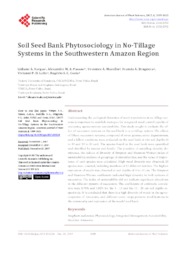Soil seed bank phytosociology in no-tillage systems in the Southwestern Amazon Region.
Soil seed bank phytosociology in no-tillage systems in the Southwestern Amazon Region.
Author(s): VARGAS, L. A.; PASSOS, A. M. A.; MARCILIO, V. A.; BRUGNERA, F. A.; LEITE, V. P. D.; COSTA, R. S. C.
Summary: Understanding the ecological dynamics of weed populations in no-tillage systems is important to establish strategies for integrated weed control capable of increasing agroecosystem sustainability. This study sought to evaluate the effect of succession systems on the seed bank in a no-tillage system. The effects of fifteen succession systems, composed of seven grasses, seven Leguminosae , and a fallow condition, were evaluated on the seed bank at two soil depths (0 to 10 and 10 to 20 cm). The species found in the seed bank were quantified and identified by species and family. The precision of sampling, density, dominance, the indices of diversity of Simpson and Shannon-Weiner; index of sustainability; analysis of groupings of dissimilarities; and the value of importance of each species were calculated. High weed diversity was observed; 29 species were counted, including members of 12 different families. The highest expression of weeds was observed at soil depths of 0 to 10 cm. The Simpson and Shannon-Weiner coefficients indicated high diversity in both systems of succession. The index of sustainability did not indicate significant alterations in the different systems of succession. The coefficients of confenetic correlation were 0.74% and 0.82% for the 0 - 10 and the 10 - 20 cm soil depths respectively. It is concluded that there is a high diversity of weeds in the agroecosystems of Amazonia, and different cover crops promote modifications in the community and expression of the weeds? seed bank.
Publication year: 2017
Types of publication: Journal article
Unit: Embrapa Maize & Sorghum
Keywords: Fitossociologia, Plantio direto, Sorghum sudanense
Observation
Some of Embrapa's publications are published as ePub files. To read them, use or download one of the following free software options to your computer or mobile device. Android: Google Play Books; IOS: iBooks; Windows and Linux: Calibre.
Access other publications
Access the Agricultural Research Database (BDPA) to consult Embrapa's full library collection and records.
Visit Embrapa Bookstore to purchase books and other publications sold by Embrapa.

